MARIANI’S
Virtual
Gourmet
October
18, 2015
NEWSLETTER
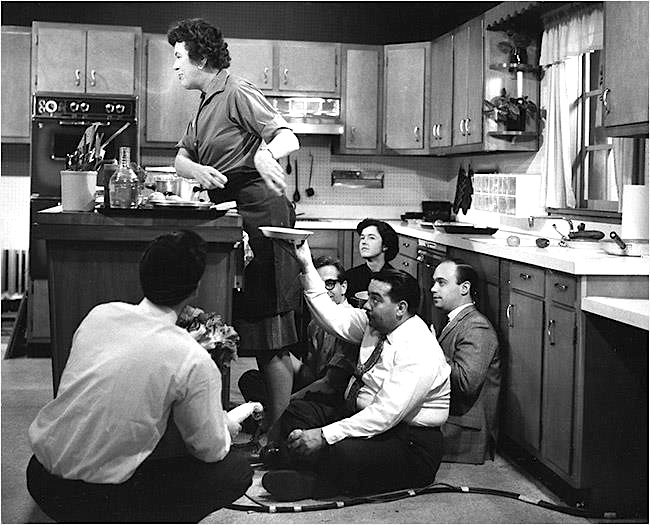
Julia
Child on set for "The French Chef"
IN THIS ISSUE
HOW TO SURVIVE EATING
OUT WITH YOUR KIDS
By
John Mariani
FINE DINING IS DOING. . .
VERY VERY WELL
By John Mariani
NEW YORK CORNER
IL PRINCIPE and STORICO
By John Mariani
NOTES FROM THE WINE CELLAR
PATIENCE IS THE KEY FOR
DAMILANO BAROLO
By John Mariani
❖❖❖
HOW TO
SURVIVE EATING
OUT WITH YOUR KIDS
By John Mariani

The first time I
took my first-born son to dinner he was three
weeks old and strapped to my chest in a Snugli. Frankly,
I would have preferred to be out alone with my
wife after 21 days of sleepless nights and
constant fretting, but since we couldn’t get a
sitter and desperately needed a night out, he came
with us. It was a very good Chinese
restaurant and he slept through the entire meal.
We later took him to restaurants in France
and Italy, carrying him in an open straw basket,
praying he wouldn’t wake up just as the sommelier
was opening the wine. We found out quickly that
Italians adore having babies and children in their  restaurants,
while the French love having dogs but abhor having
children in the dining room.
restaurants,
while the French love having dogs but abhor having
children in the dining room.
I recall one Italian restaurateur in Alba
picking my fifteen-month-old son up and handing him
to his wife, who was also the chef; she, in turn,
plopped him down in the kitchen where other females
delighted and fed him while we dined blissfully for
the next two hours pretending to be unaware that
he’d disappeared into the steamy, wonderful aromas
of the kitchen.
After that, he rarely balked at
going out to dinner with us. Nor did his
brother, born four years later, when the two of them
were actually old enough to sit at a restaurant
table and behave in some primitive fashion. I don’t
know why it is, but American parents seem challenged
by the idea of taking their kids to dinner—as
opposed to a fast food joint of the kids’
choosing—while in Europe and Asia, parents believe
such activity is crucial to a child’s education,
health and well being.
That said, here are some tips for
taking (American) kids out to eat.
Favor Italian, Mexican or Chinese
restaurants because invariably the kids will find
something crispy, fried, or with cheese melted  on it.
on it.
Don’t
let them order. Just choose several items,
especially those they are not familiar with, and
have the waiter set them all on the table family
style. When they ask, “What’s that?” just say, “Try
it.” If they say, “What if I hate it?” reply, “Then
don’t try it.” I can guarantee their appetites and
salivary glands will propel them to try something,
maybe everything, as long as you don’t try to force
them to. And they will like
it and become more and more adventurous.
Tell
the manager or waiter to get something to nibble on
to the table immediately—bread and butter, Mexican
chips, Chinese noodles. Kids blood sugar levels
cause them to be cranky if not fed when hunger
strikes.
Be
prepared to order quickly for the same reason. Don’t
dawdle or let your wife declare, “Oh, everything
looks sooooo
good, I don’t know what to choose.” The
one-minute-forty-five second rule should be enforced
that everyone has to make a choice within that time
frame.
Ask
for a table near the rest rooms and one you can get
up from easily. You know why.
 Small
children might be allowed small toys at the table
but stifle their mania for playing video games at
the youngest possible age. Same with iphones and
Blackberries.
Small
children might be allowed small toys at the table
but stifle their mania for playing video games at
the youngest possible age. Same with iphones and
Blackberries.
See
if you can get a waitress rather than a waiter. The
former tend to be much more patient, even maternal.
Dessert
should be a reward for good behavior.
If
you must take children to a fancy, deluxe
restaurant, alert the manager and tell him you will
be in and out in a civilized 90-minute span. Get the
check when you order dessert.
The
cut-off age you can expect kids to behave at a
restaurant is twelve, after which teenagers are
impossible to please because they can think of
nothing 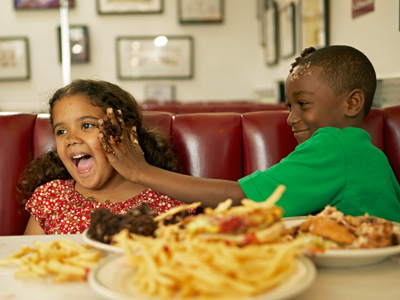 more repellant than to
be seen eating out with their parents. It’s also
when they start to concoct their own idiotic diet
requirements and suddenly find everything you’d
suggest from a menu abominable or inedible. Wait till
they’re eighteen—at least your daughter—then try to
coax them out to a fine restaurant.
more repellant than to
be seen eating out with their parents. It’s also
when they start to concoct their own idiotic diet
requirements and suddenly find everything you’d
suggest from a menu abominable or inedible. Wait till
they’re eighteen—at least your daughter—then try to
coax them out to a fine restaurant.
If
a kid has gone vegetarian, just check the
restaurant’s menu and tell the management. In most
restaurants it’s not a problem at all. But if the
kid has gone vegan (where did you go wrong?), there
is no way in hell you will ever please
him, so just forget going out entirely.
❖❖❖
FINE DINING IS DOING. . . . VERY, VERY WELL
By John Mariani
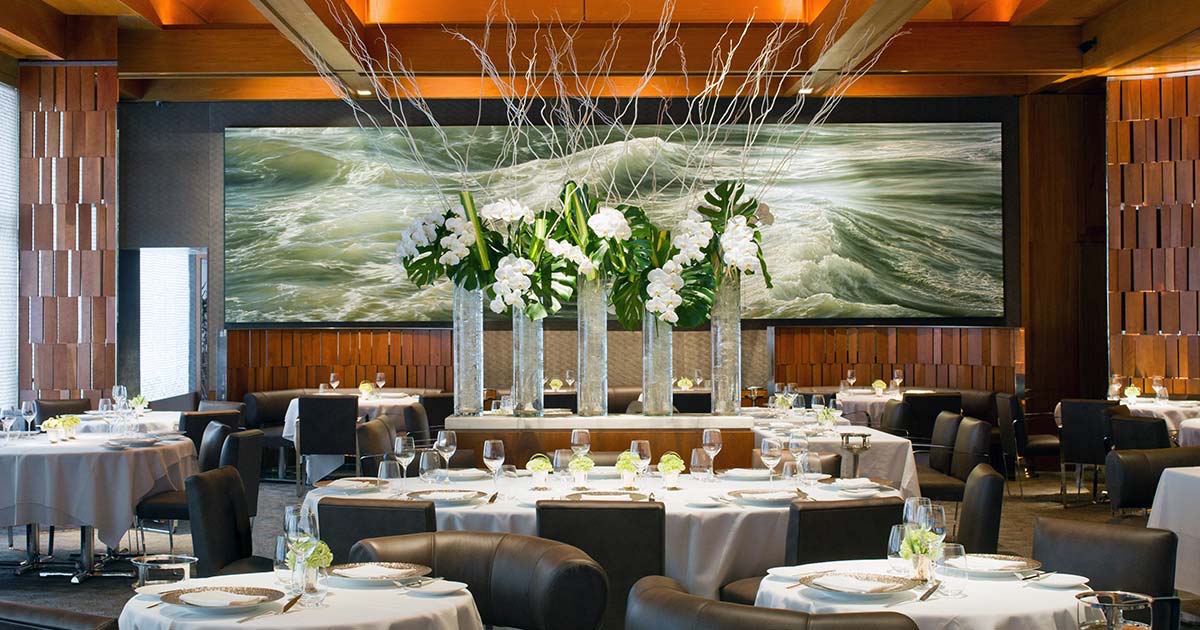
 I’d be the last to
recommend Zagat as a reliable ratings system,
whereby a burrito stand gets the same number of
points as an haute cuisine French restaurant and
no restaurant rates lower than “good to very
good.” But if the highest number of people give
the highest points for food and décor to a
restaurant in such a survey, it is worth taking
seriously as an indicator of excellence.
I’d be the last to
recommend Zagat as a reliable ratings system,
whereby a burrito stand gets the same number of
points as an haute cuisine French restaurant and
no restaurant rates lower than “good to very
good.” But if the highest number of people give
the highest points for food and décor to a
restaurant in such a survey, it is worth taking
seriously as an indicator of excellence.
In that respect, it is well worth
noting that in this year’s edition of the Zagat NYC
guide 2016, the ten restaurants that scored highest
in both food and décor are, with the exception of
Peter Luger Steak House in Brooklyn, all high-end
haute cuisine restaurants, and very expensive for
that. The
list might be eye-widening if half the restaurants
on it were storefronts on the Lower East Side or a
ramen noodle joint in Bensonhurst. But, no:
Despite all the food media rants about the demise of
fine dining in NYC, the Zagat list suggests
otherwise. Not
only is fine dining, with all its attendant décor,
capital investments, service staff and extensive
menus, alive and well but clearly and convincingly
registers at the very top with those who vote in the
guide.
It is, then, something of
a disconnect when magazines like Bon Appetit,
Food & Wine, GQ and Esquire’s
best new restaurant lists for 2015 almost never
include such establishments (though they have no
problem with cramped, unattractive, sterile
restaurants serving $200 tasting menus) and the NY Times
critic gives three stars to a vegetarian hamburger
eatery, that traditional fine dining does not just
survives but thrives at the very top of popularity
among the dining public. Not surprisingly, the
list bears strong resemblance to the three- and
two-star rankings in the recently released Michelin Guide
to NYC.
This wealth of fine dining
establishments may not be as evident in many other
American cities, like Los Angeles, Houston, Miami,
and Atlanta, whose dining public has largely
abandoned traditional fine dining. But it is
still very true in NYC, San Francisco, Chicago, and
Las Vegas.
Here then are Zagat’s best-rated
restaurants for 2015 in NYC. They well deserve the
honor:
1. Le
Bernardin (food: 29; décor: 28)
2. Bouley
(food: 29; décor: 28)
3. Daniel
(food: 29; décor: 28)
4. Jean-Georges
(food: 29; décor: 28)
5. Gotham
Bar and Grill (food: 28; décor: 26)
6. Peter
Luger Steak House (food: 28; décor:
17)
7. Eleven
Madison Park (food: 28; décor: 28)
8. Blue
Hill (food: 28; décor: 23)
9. Per
Se (food: 28; décor: 27)
10.
Gramercy
Tavern (food: 28; décor: 26)
❖❖❖
TWO ITALIAN RESTAURANTS
OFF THE BEATEN TRACK
By John Mariani
While the "hot" neighborhoods
of Brooklyn and the Lower East Side keep the
food media busy lavishing every scuzzy
storefront with praise, there are other
restaurants a little off the beaten track that
offer fine food and far lovelier surroundings
for a civilized meal.
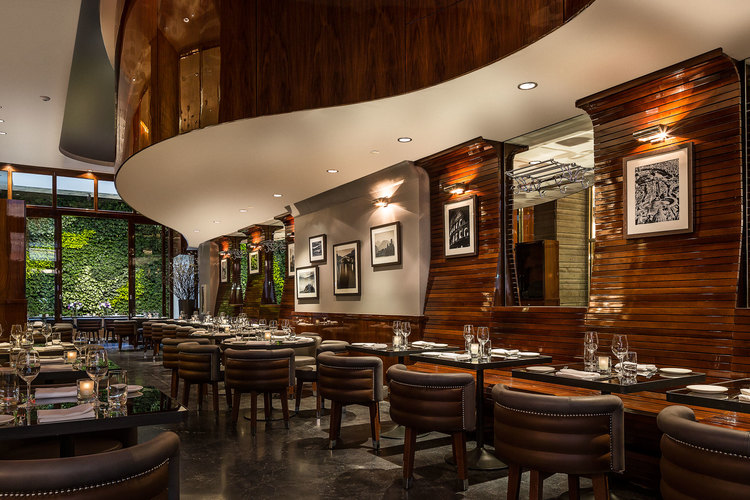 IL PRINCIPE
IL PRINCIPE
Hugo Hotel
525 Greenwich Street (near Canal
Street)
212-608-4848
ilprincipeny.com
Il Principe is a
stunningly good looking one-year-old restaurant in
the Hugo Hotel, wedged in between TriBeCa, SoHo
and the West Village, just across from the
blocks-long UPS garage, in a quarter dubbed Hudson
Square. Architect Marcello Pozzi has done a superb
job of marrying the elegance of wood and
industrial materials throughout, including the
glass-enclosed lobby, the restaurant bar and a
Rooftop Bar with a glorious 360-degree view of the
city and the Hudson River. The
lighting in the dining room bespeaks elegant
modernity of a kind you’d find in Milan right now,
the walls hung with striking black and white
photos, the soft gray fabric chairs are very
comfortable, and in the rear, beyond a glass wall,
is an ivy-walled patio that seems miles away from
the city’s hectic pace, noise and UPS trucks.
Manila-born Chef Kristine
Mana-ay, who has done stints at Waverly Inn and
The Lion, is doing a fine rendering of
Italian classic cuisine with considerable finesse,
evident in her silken beef carpaccio dressed with
Parmigiano ($14). Bluefin tuna tartare ($16) comes
with avocado, a pinch of peperoncino and some refreshing
mint. 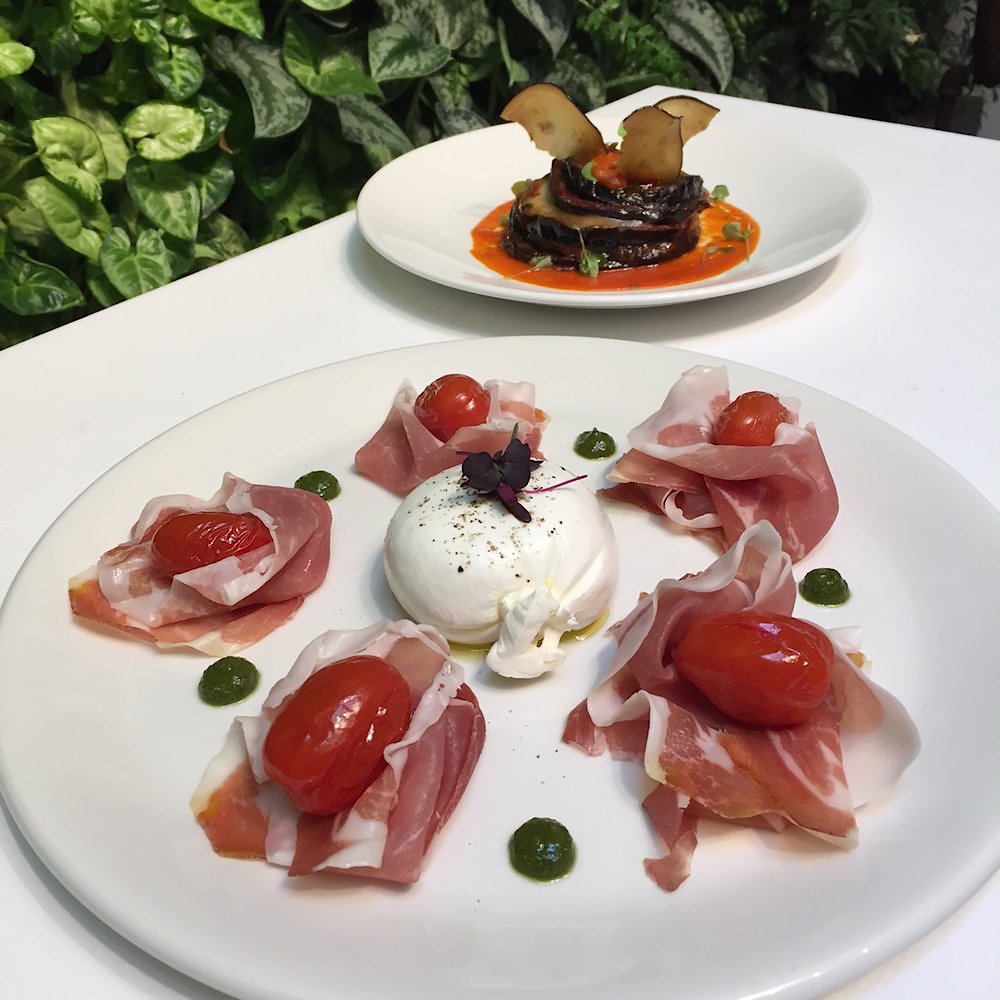 There is also
a good pizzette
($18) of the thin-crust variety, with
caramelized onion, fontina, a touch of thyme and a
brushing of truffle oil.
There is also
a good pizzette
($18) of the thin-crust variety, with
caramelized onion, fontina, a touch of thyme and a
brushing of truffle oil.
The pastas were all excellent, from
veal canelloni—a dish you don’t see much anymore
but should—in a light, creamy besciamella
($22, as a main course portion), and
perfectly cooked garganelli
with veal sausage ragù, white wine sauce and
truffled pecorino cheese ($22). Rarely
will you find the Piemontese signature pasta agnolotti del
plin (left) on a menu this side of
Turin, but, although Mana-ay’s are considerably
larger than the traditional thumbnail-sized
nubbins of pasta, the dish as a whole is
absolutely wonderful, with spinach, ricotta and a
dressing of good butter and sage ($17).
For a main course I recommend
the simple dish of impeccably cooked, flaky branzino with
lemon,
olives and capers ($27), or the chicken alla diavola
($26) with crushed peperoncino that makes this
“devilishly” hot, potatoes and lots of garlic. In
light of all this goodness,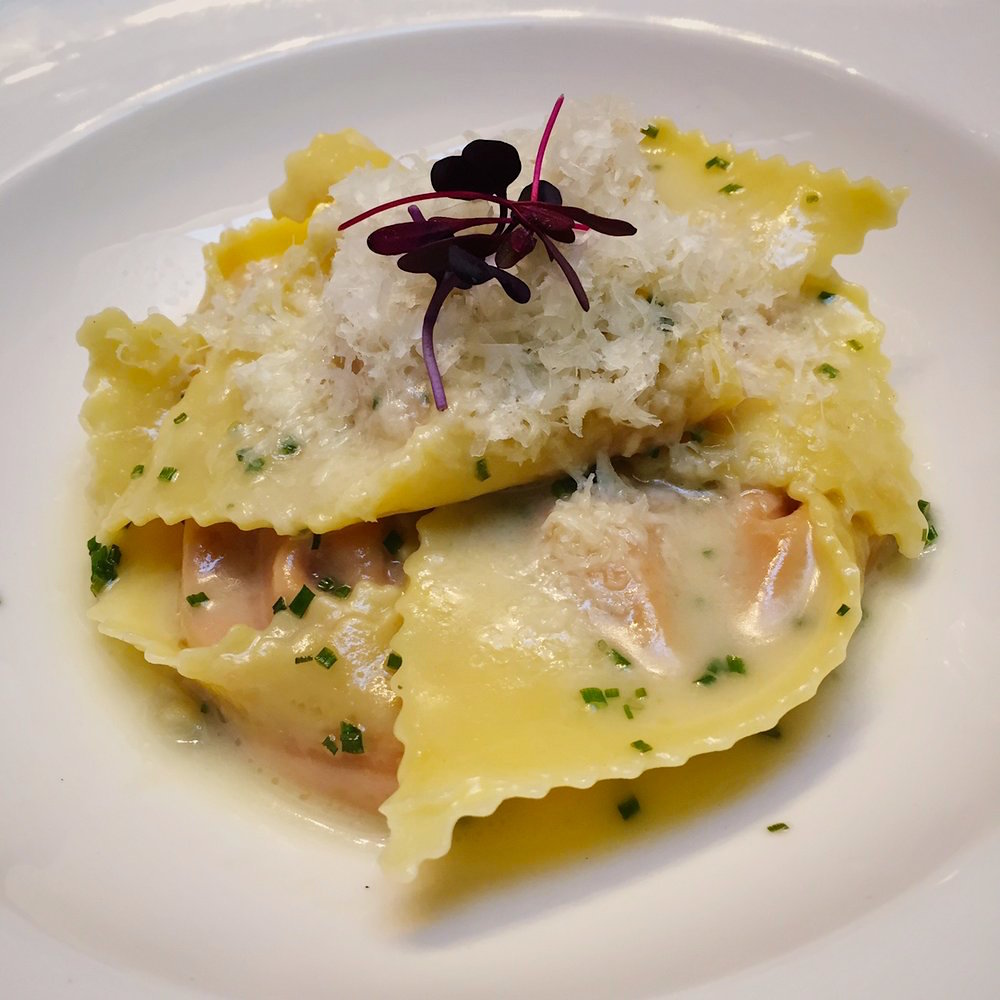 I was very
disappointed in a ribeye ($35) ordered medium
rare, which came out barely pink and tasted more
like pork than beef.
I was very
disappointed in a ribeye ($35) ordered medium
rare, which came out barely pink and tasted more
like pork than beef.
The
desserts don’t fall far from the usual listings,
such as tiramisù ($12), chocolate torta
($12) and panna
cotta ($10), but they are well made, and I
particularly liked the flaky sfogliatina
of caramelized puff pastry, milk gelato,
red wine-poached figs and caramel sauce ($12).
Each dessert comes with a recommendation for a
dessert wine.
The wine list itself is of
moderate size and very high priced, with far more
bottles above $100 than below.
I am always careful not to make
too much of poor service on any given night, but,
owing to the dining room being nearly empty, I
would have thought more attention to the few
occupied tables would be paid so that I wouldn’t
have to ask the waiter to come over or ask if the
wine I ordered was going to come before I finished
my appetizers.
A busier restaurant is almost always a
better one, so I hope this is the case at Il
Principe, which deserves a wider audience.
Caffé Storico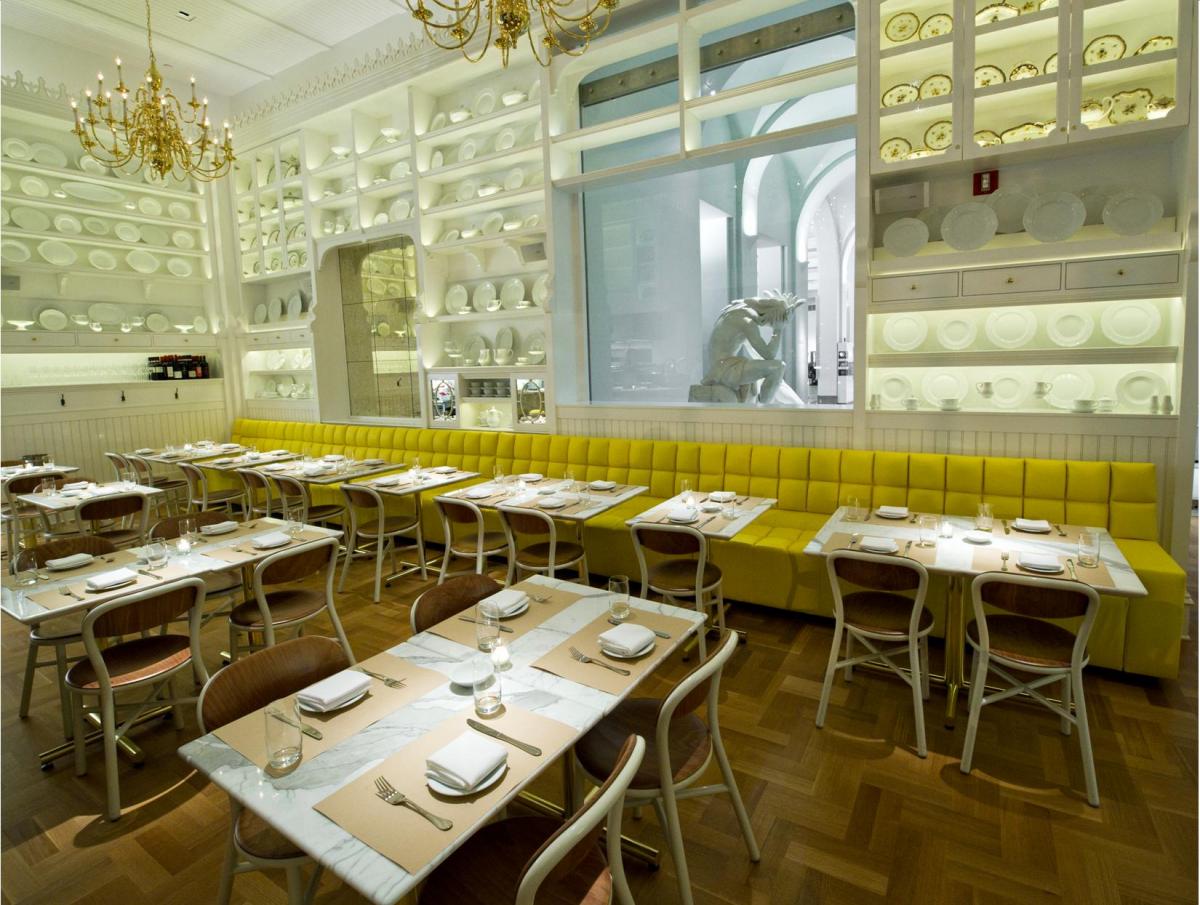
New York Historical Society
170 Central Park West (at 77th
Street)
212-873-3400
nyhistory.org/d
The Upper West Side
continues to grow in gastronomic clout but not,
thank God, with the same frenzy as downtown. Of
course, you’d expect a restaurant set within the
New York Historical Society to have a certain
refinement, and Caffé
Storico has plenty of that, fitting snugly
into the
museum’s north corner. Its stately windows let in
the Central Park
daylight against milk white walls and wood, a
gleaming historic brass chandelier, lemon yellow
banquettes, a marble counter, open kitchen and a
window into the sculpture arcade. At
night (if they don’t inexplicably turn the lights
down) the setting becomes soft and comforting.
Fifteen-foot shelves are set with antique
chinaware from the museum's vast collection,
giving the large space a cheery, homey look, if
your home was arrayed with such a bounty of
beautiful objects. The restaurant and menu
were brought to the city three years ago by
Philadelphia's restaurant maestro Stephen Starr
(who also translated Buddakan and Morimoto to New
York).
There’s a new chef here, Edward Crochet,
but he’s toeing the same line of light Italian
fare, and
you can nibble on antipasti and pasta to your
heart’s content and not make a dent in the
entrees. The burrata ($15)
here is as creamy as it should be, with heirloom
tomato and a little basil, and the ricotta and
chickpea
crostini ($10) come as they would in Italy,
with a thin slice of lardo.
It’s a good idea to share the salumi
board ($19) meant for two or three, with sweet
fruit mostardo
and grilled bread.
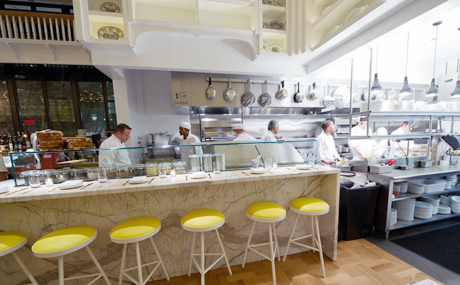 Among
the pastas the spinach and ricotta strozzapreti
(“priest stranglers”) were tender and delicious,
just touched with a hint of dill butter and sesame
($15), and the corn-plumped tortelli ($15)
were
very delicate, with chilies and breadcrumbs for
heat and texture.
Lamb lasagna ($18) is the lustiest of the
pastas, with bitter-salty broccoli di rabe.
Among
the pastas the spinach and ricotta strozzapreti
(“priest stranglers”) were tender and delicious,
just touched with a hint of dill butter and sesame
($15), and the corn-plumped tortelli ($15)
were
very delicate, with chilies and breadcrumbs for
heat and texture.
Lamb lasagna ($18) is the lustiest of the
pastas, with bitter-salty broccoli di rabe.
I’m not sure why this menu
features tilefish with tomato dashi, bok choy and
olives ($27), which seems out of style here. The
stuffed rabbit loin ($25) is very good, with
fennel and onion mostarda,
but the pork loin with shishito peppers, peaches
and cilantro ($26) was rather dry.
Desserts ($8-$10) offer some
very good housemade gelati,
along with a peach crostata scented
with Thai basil gelato,
and a richly satisfying coffee cake with dulce de
leche and chocolate.
At lunch Caffé Storico gets a
crowd of visitors from the Historic Society and
Museum of Natural History across the street, and
at dinner an admirably local bunch of regulars. Everyone
basks in the radiance of the place, which is as
expressive of what is so unique and very fine
about a museum as cherished as the New York
Historical Society.
Caffé Storico is open for lunch
Mon.-Sat., for dinner nightly, for brunch on
Sunday.
❖❖❖
PATIENCE IS THE KEY FOR DAMILANO BAROLO
By John Mariani
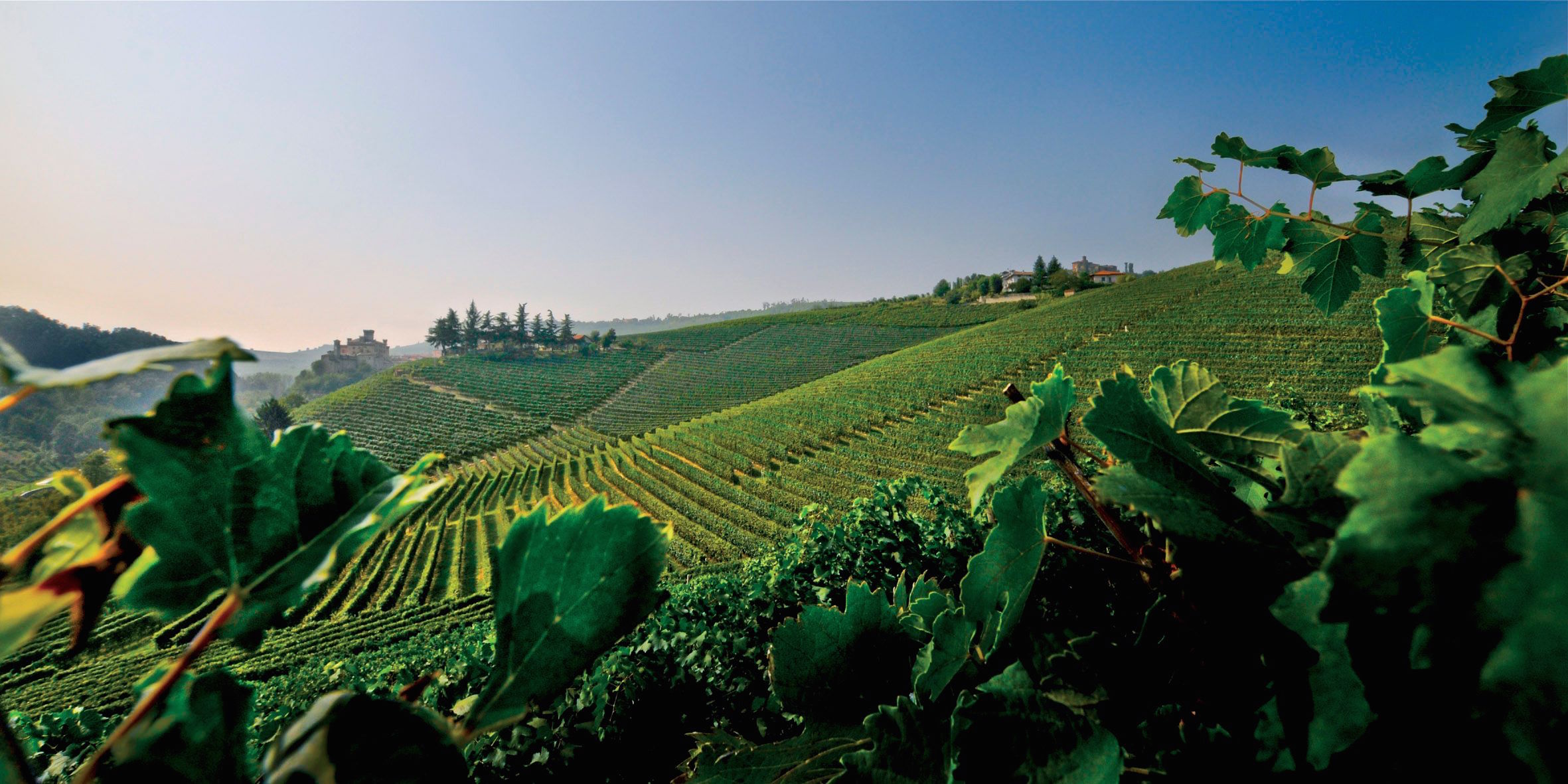
I
wouldn’t call it a raging debate, but in Italy’s
Piedmont region there are two schools of thought
as to how to make one of its two most famous
wines, Barolo, made from the Nebbiolo grape. (The
other is Barbaresco, made from the same grape.)
On one side are the traditional
Barolo makers, like Marchesi di Barolo, Giuseppe
Rinaldi and Giacomo Conterno, whose long-aged
wines have set a standard for big-hearted,
mouth-filling, complex wines that are meant to be
put away until they mature. On the
other side are younger wineries like Scarzello,
Paolo Conterno and Cascina Ebreo Torbido, whose
wines tend to be a bit lighter and are more ready
to drink soon after release.
Barolo takes its name from a
Piedmontese village surrounded by vineyards, and
the wine has been made as a dry, tannic red since
the mid-19th century. As “The wine of kings and
the king of wines” favored by the aristocratic
families of Turin, Barolo always had a local
cachet, and over the next century the Barolo
production region was expanded to include five
principal towns upholding the tradition of rich,
highly concentrated, long-lived wines.
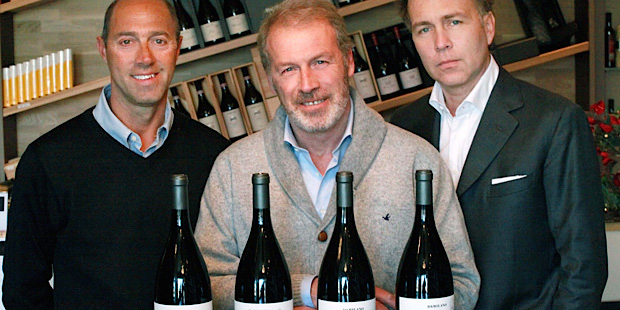 In
the past, fermentation and maceration could last
up to two months, so that in big vintages the
alcohol level could rise above 15%. Those made
since the mid-1980s in a more modern style
emphasize softness over tannins and an earlier
release time over high alcohol. Traditionalists
argue that such wines are thin and tend to oxidize
more quickly.
In
the past, fermentation and maceration could last
up to two months, so that in big vintages the
alcohol level could rise above 15%. Those made
since the mid-1980s in a more modern style
emphasize softness over tannins and an earlier
release time over high alcohol. Traditionalists
argue that such wines are thin and tend to oxidize
more quickly.
Somewhere
in the middle of these contrasting but
complementary philosophies is Damilano Barolo,
whose reputation since 1890 has put it in the
highest ranks in the region. The estate is now
owned and run by Mario, Guido and Paolo Damilano (left), who
have expanded it and brought in the most
up-to-date technology to make their wines while
always keeping a very careful eye on their
family’s traditions. Production is now 322,00
bottles annually, the most prestigious being the
Barolo crus—-Cannubi, Brunate, Cerequio and Liste;
the first two are considered the most elegantly
knit and complex.
Over dinner at New York’s
Lincoln Ristorante, Paolo Damilano focused on the
Cannubi cru (about 50,000 bottles), considering
the wine “a big responsibility” and noting that
Cannubi is actually an older name than Barolo,
dating back to 1752; it means “a mix
of soil” in the local dialect. “They
used to `fix’ other Barolos by adding Cannubi,” he
said.
Damilano
is not alone in producing single-vineyard labels.
Most of the 948 growers in the region now do, and
recognized estates have been expanded in recent
years to maximize name recognition. But Damilano
owns ten of the fifteen treasured Cannubi hectares
(above),
on a hill that stretches from the town of Bra to
the family’s estate. The land has been subdivided
into 20 micro-areas whose vines produce
distinctive qualities that go into their Barolo
Cru and the “1752” Reserve. The
soil on the hill ranges from sand to limestone,
with magnesium oxide and manganese part of the
terroir.
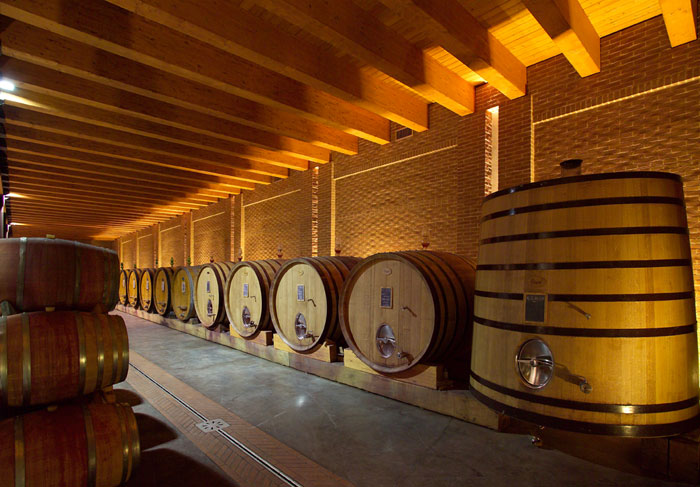 At
their modern cellars in La Molla (left), the
Damilanos use only natural yeasts, with
fermentation between eight and fifteen days. Maceration is prolonged and
the wines are racked, and the cap of grape must
is pushed down to provide a robust body and
tannins to the wines.
At
their modern cellars in La Molla (left), the
Damilanos use only natural yeasts, with
fermentation between eight and fifteen days. Maceration is prolonged and
the wines are racked, and the cap of grape must
is pushed down to provide a robust body and
tannins to the wines.
“From
the
crus we can have an extensive palette to make our
wines with,” Paolo said over a Piedmontese dinner
of raw beef called carne cruda with a gratin blue
cheese dressing and toasted walnuts, and a fritto misto
of fried quail, sweetbreads, chicken livers and
lemon mayonnaise.
“This is what we would be eating in
Piedmont right now,” he said, and it was clear how
much more enlightening it is when one drinks the
wine of the region with the food of the region.
We drank the Cannubi Cru from
the 2008 vintage ($100), a beautiful and intense
wine that shows the rich essence of the Nebbiolo
grape. “The harvests are getting later and later,”
he said, citing global warming. “It used to be in
October and now it’s in November. And we
get hail, hail, hail every year!” The
vintage was one of the latest harvests in a
decade.
With the Cannubi “1752” (also
from 2008) we enjoyed chestnut pasta with a wild
boar ragù,
porcini
mushrooms and Parmigiano-Reggiano, along with
braised shoulder of beef with sweet parsnips,
chanterelle mushrooms, baby onions and a red wine
sauce—-woodsy, hearty flavors that were wholly
enhanced by the power and structure of the 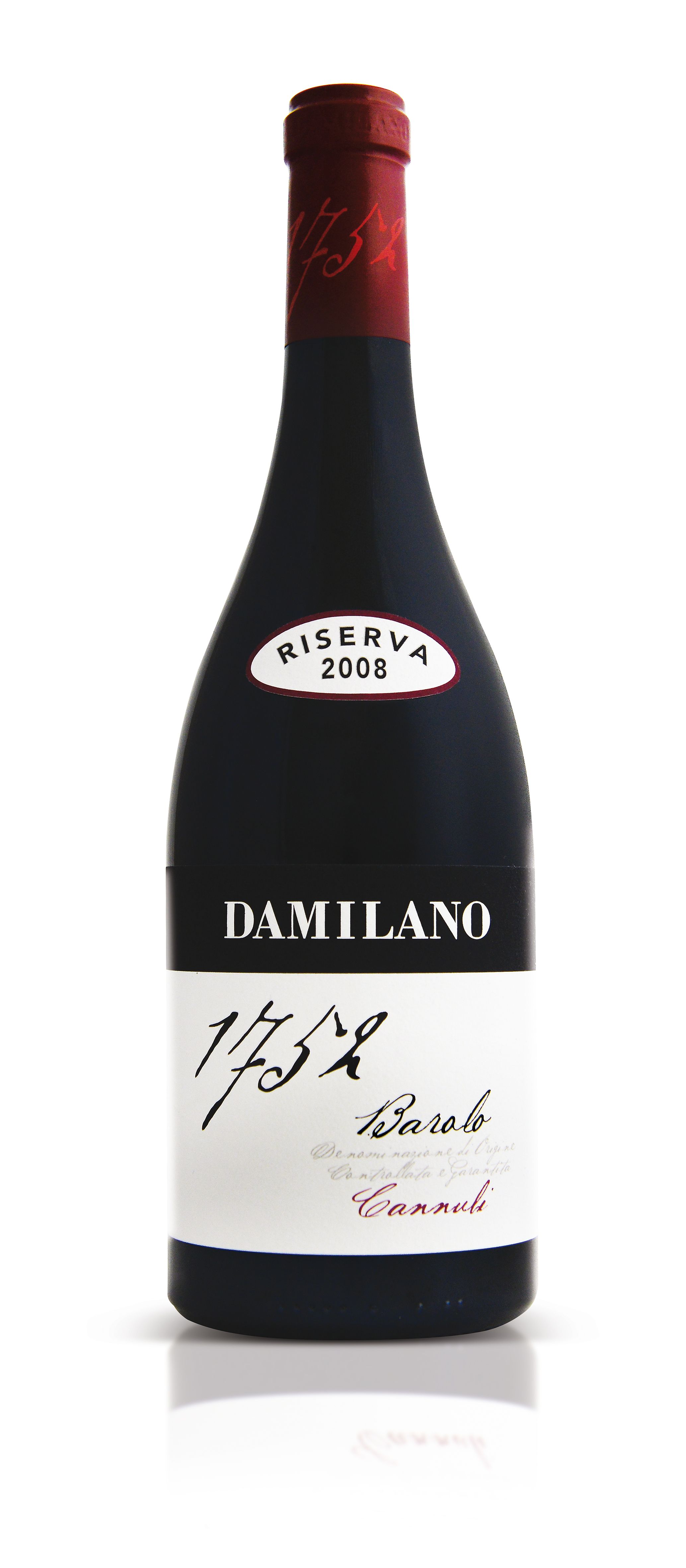 “1752,” which is only
released as a Riserva
after seven years, at 14.5 percent alcohol. Only
the very finest grapes, from vines 40 to 50 years
old that grow deep into the sub-soils, are picked,
then fermented on the grape skins for 20 days and
left with the skins for another 30. The
wine will spend 60 months in an oak barrel, then
24 more in bottle before release this year. It is
priced at $275.
“1752,” which is only
released as a Riserva
after seven years, at 14.5 percent alcohol. Only
the very finest grapes, from vines 40 to 50 years
old that grow deep into the sub-soils, are picked,
then fermented on the grape skins for 20 days and
left with the skins for another 30. The
wine will spend 60 months in an oak barrel, then
24 more in bottle before release this year. It is
priced at $275.
Damilano’s
willingness to wait—-and therefore sit on a major
capital investment—-is indicative of the estate’s
commitment to the long traditions of Barolo
making, while its modern facilities are intended
to keep the grapes and wines as healthy and bright
as possible.
Paolo was very happy because
his wines showed so well with food with which he
was very familiar, declaring Lincoln the best
Italian restaurant he had eaten in in New York. His
family runs a fine restaurant named Massimo Camia
on the Damilano estate that specializes in similar
Piedmontese cuisine; it serves several dishes
quite like what he enjoyed at Lincoln.
“When you have
such high quality of wine made with such passion
and care as my family has,” he said, “you always
want to marry it to food of the same quality,
which is rare outside of Piedmont. When
you are as proud as my family is of what we do, we
have to be patient.
We try to make the very best Barolo wines
we know how to make, but also wines as fine as any
in Italy or the world.”
❖❖❖
. . . AND THE SALADS
WITH A SIDE OF SOYLENT GREEN
“Nearly every dish at Gaia comes with plastic serving spoons and a crumpled foil trough full of freshly house-baked focaccia soldiers.”—Silvia Killingsworth, “Gaia Italian Café,” The New Yorker (June 22, 2015).
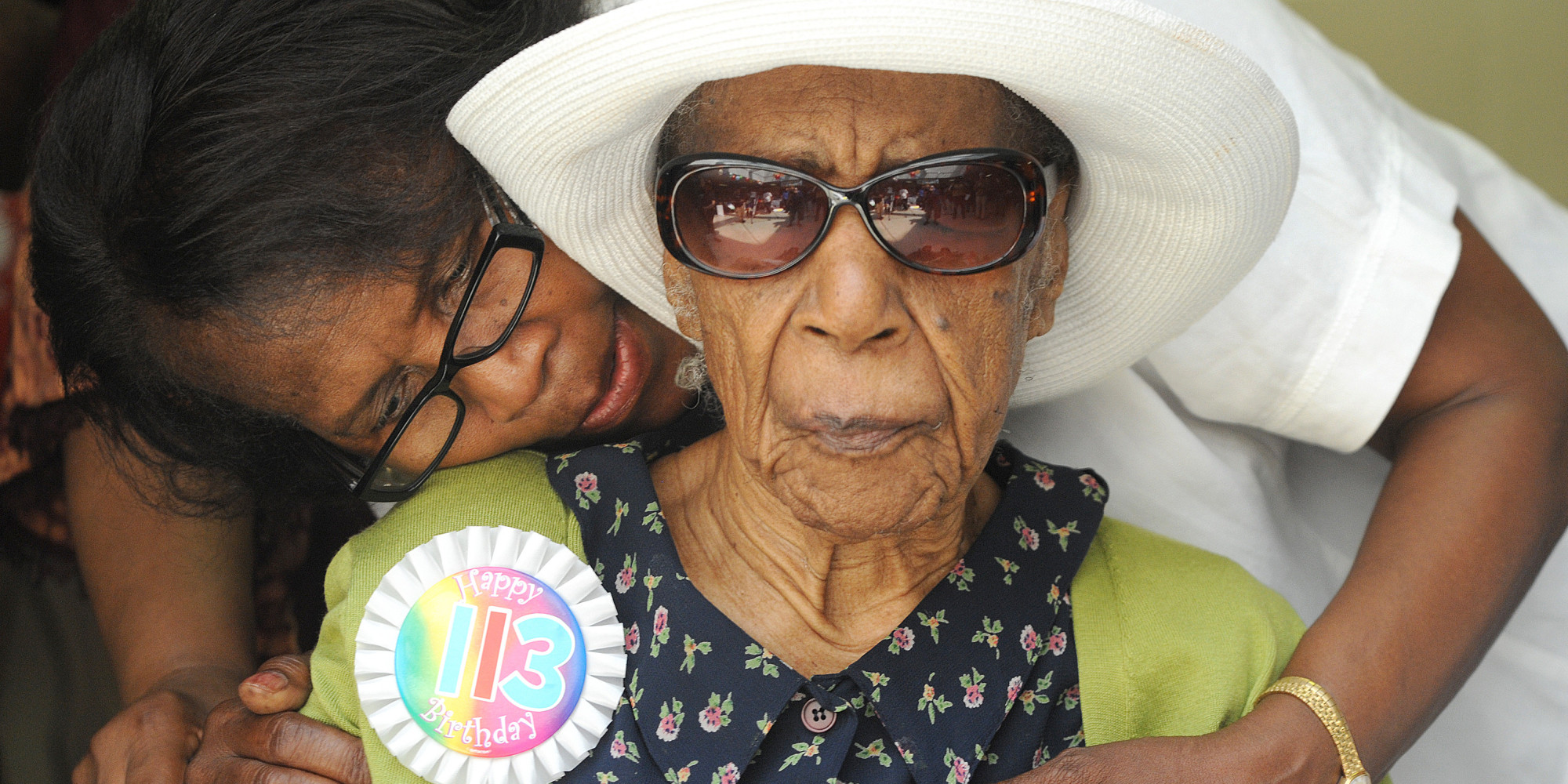
A RASHER A DAY. . .
At 116 years old, Susannah Mushatt Jones (left) is the
world’s certified oldest living person, who
told the
Any of John Mariani's books below may be ordered from amazon.com.
 I'm proud and happy to announce that my
new book, The Hound
in Heaven (21st Century Lion Books), has just
been published through Amazon and Kindle.
I'm proud and happy to announce that my
new book, The Hound
in Heaven (21st Century Lion Books), has just
been published through Amazon and Kindle. It is a novella, and for anyone who loves dogs, Christmas, romance, inspiration, even the supernatural, I hope you'll find this to be a treasured favorite. The story concerns how, after a New England teacher, his wife and their two daughters adopt a stray puppy found in their barn in northern Maine, their lives seem full of promise. But when tragedy strikes, their wonderful dog Lazarus and the spirit of Christmas are the only things that may bring back his master back from the edge of despair.
WATCH THE VIDEO!
“What a huge surprise turn this story took! I was completely stunned! I truly enjoyed this book and its message.” – Actress Ali MacGraw
“He had me at Page One. The amount of heart, human insight, soul searching, and deft literary strength that John Mariani pours into this airtight novella is vertigo-inducing. Perhaps ‘wow’ would be the best comment.” – James Dalessandro, author of Bohemian Heart and 1906.
“John Mariani’s Hound in Heaven starts with a well-painted portrayal of an American family, along with the requisite dog. A surprise event flips the action of the novel and captures us for a voyage leading to a hopeful and heart-warming message. A page turning, one sitting read, it’s the perfect antidote for the winter and promotion of holiday celebration.” – Ann Pearlman, author of The Christmas Cookie Club and A Gift for my Sister.
“John Mariani’s concise, achingly beautiful novella pulls a literary rabbit out of a hat – a mash-up of the cosmic and the intimate, the tragic and the heart-warming – a Christmas tale for all ages, and all faiths. Read it to your children, read it to yourself… but read it. Early and often. Highly recommended.” – Jay Bonansinga, New York Times bestselling author of Pinkerton’s War, The Sinking of The Eastland, and The Walking Dead: The Road To Woodbury.
“Amazing things happen when you open your heart to an animal. The Hound in Heaven delivers a powerful story of healing that is forged in the spiritual relationship between a man and his best friend. The book brings a message of hope that can enrich our images of family, love, and loss.” – Dr. Barbara Royal, author of The Royal Treatment.
 |
The Encyclopedia of American Food and Drink by John F. Mariani (Bloomsbury USA, $35) Modesty forbids me to praise my own new book, but let me proudly say that it is an extensive revision of the 4th edition that appeared more than a decade ago, before locavores, molecular cuisine, modernist cuisine, the Food Network and so much more, now included. Word origins have been completely updated, as have per capita consumption and production stats. Most important, for the first time since publication in the 1980s, the book includes more than 100 biographies of Americans who have changed the way we cook, eat and drink -- from Fannie Farmer and Julia Child to Robert Mondavi and Thomas Keller. "This book is amazing! It has entries for everything from `abalone' to `zwieback,' plus more than 500 recipes for classic American dishes and drinks."--Devra First, The Boston Globe. "Much needed in any kitchen library."--Bon Appetit. |
"Eating Italian will never be the same after reading John Mariani's entertaining and savory gastronomical history of the cuisine of Italy and how it won over appetites worldwide. . . . This book is such a tasteful narrative that it will literally make you hungry for Italian food and arouse your appetite for gastronomical history."--Don Oldenburg, USA Today. "Italian
restaurants--some good, some glitzy--far
outnumber their French rivals. Many of
these establishments are zestfully described
in How Italian Food Conquered the World, an
entertaining and fact-filled chronicle by
food-and-wine correspondent John F.
Mariani."--Aram Bakshian Jr., Wall Street
Journal.
"Equal parts
history, sociology, gastronomy, and just
plain fun, How Italian Food Conquered the
World tells the captivating and delicious
story of the (let's face it) everybody's
favorite cuisine with clarity, verve and
more than one surprise."--Colman Andrews,
editorial director of The Daily
Meal.com. "A fantastic and fascinating
read, covering everything from the influence
of Venice's spice trade to the impact of
Italian immigrants in America and the
evolution of alta cucina. This book will
serve as a terrific resource to anyone
interested in the real story of Italian
food."--Mary Ann Esposito, host of PBS-TV's
Ciao
Italia. "John Mariani has written the
definitive history of how Italians won their
way into our hearts, minds, and
stomachs. It's a story of pleasure over
pomp and taste over technique."--Danny Meyer,
owner of NYC restaurants Union Square
Cafe, The Modern, and Maialino.
|
 |
 |
 |
 |
 |
 |
 |
 |
 Everett Potter's Travel Report:
Everett Potter's Travel Report: 
 Eating Las
Vegas is the new on-line site for
Virtual Gourmet contributor John A. Curtas.,
who since 1995 has been commenting on the
Las Vegas food scene and reviewing
restaurants for Nevada Public Radio.
He is also the restaurant critic for KLAS
TV, Channel 8 in Las Vegas, and his past
reviews can be accessed at KNPR.org.
Click on the logo below to go directly to
his site.
Eating Las
Vegas is the new on-line site for
Virtual Gourmet contributor John A. Curtas.,
who since 1995 has been commenting on the
Las Vegas food scene and reviewing
restaurants for Nevada Public Radio.
He is also the restaurant critic for KLAS
TV, Channel 8 in Las Vegas, and his past
reviews can be accessed at KNPR.org.
Click on the logo below to go directly to
his site.

Tennis Resorts Online: A Critical Guide to the World's Best Tennis Resorts and Tennis Camps, published by ROGER COX, who has spent more than two decades writing about tennis travel, including a 17-year stretch for Tennis magazine. He has also written for Arthur Frommer's Budget Travel, New York Magazine, Travel & Leisure, Esquire, Money, USTA Magazine, Men's Journal, and The Robb Report. He has authored two books-The World's Best Tennis Vacations (Stephen Greene Press/Viking Penguin, 1990) and The Best Places to Stay in the Rockies (Houghton Mifflin, 1992 & 1994), and the Melbourne (Australia) chapter to the Wall Street Journal Business Guide to Cities of the Pacific Rim (Fodor's Travel Guides, 1991).


MARIANI'S VIRTUAL GOURMET
NEWSLETTER is published weekly. Editor/Publisher: John
Mariani.
Editor: Walter Bagley. Contributing Writers: Christopher Mariani,
Robert Mariani, Misha
Mariani,
John A. Curtas, Edward Brivio, Mort Hochstein,
Andrew Chalk, Dotty Griffith and Brian Freedman. Contributing
Photographers: Galina Dargery, Bobby
Pirillo. Technical Advisor: Gerry McLoughlin.
To un-subscribe from this newsletter,click here.
© copyright John Mariani 2015

